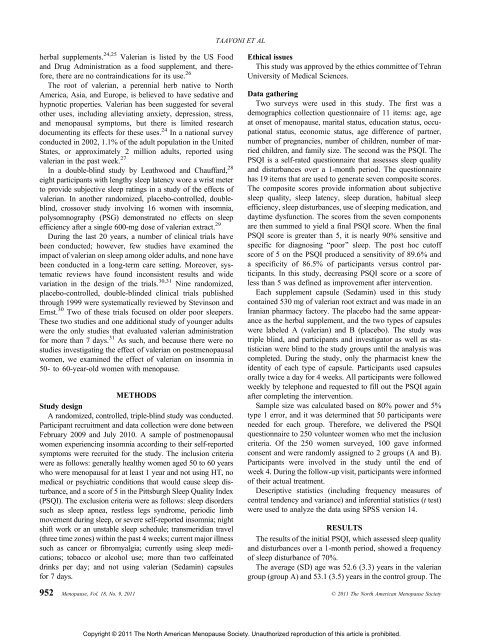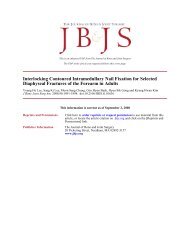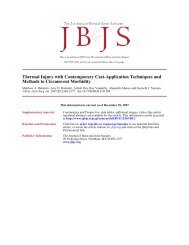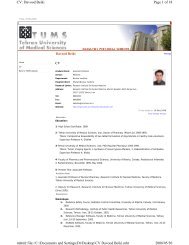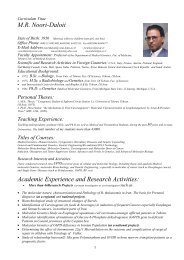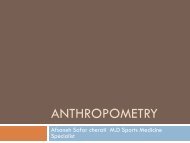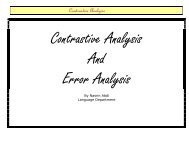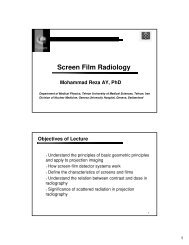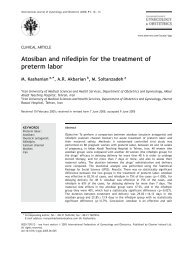Effect of valerian on sleep quality in postmenopausal women: a ...
Effect of valerian on sleep quality in postmenopausal women: a ...
Effect of valerian on sleep quality in postmenopausal women: a ...
Create successful ePaper yourself
Turn your PDF publications into a flip-book with our unique Google optimized e-Paper software.
herbal supplements. 24,25 Valerian is listed by the US Food<br />
and Drug Adm<strong>in</strong>istrati<strong>on</strong> as a food supplement, and therefore,<br />
there are no c<strong>on</strong>tra<strong>in</strong>dicati<strong>on</strong>s for its use. 26<br />
The root <str<strong>on</strong>g>of</str<strong>on</strong>g> <str<strong>on</strong>g>valerian</str<strong>on</strong>g>, a perennial herb native to North<br />
America, Asia, and Europe, is believed to have sedative and<br />
hypnotic properties. Valerian has been suggested for several<br />
other uses, <strong>in</strong>clud<strong>in</strong>g alleviat<strong>in</strong>g anxiety, depressi<strong>on</strong>, stress,<br />
and menopausal symptoms, but there is limited research<br />
document<strong>in</strong>g its effects for these uses. 24 In a nati<strong>on</strong>al survey<br />
c<strong>on</strong>ducted <strong>in</strong> 2002, 1.1% <str<strong>on</strong>g>of</str<strong>on</strong>g> the adult populati<strong>on</strong> <strong>in</strong> the United<br />
States, or approximately 2 milli<strong>on</strong> adults, reported us<strong>in</strong>g<br />
<str<strong>on</strong>g>valerian</str<strong>on</strong>g> <strong>in</strong> the past week. 27<br />
In a double-bl<strong>in</strong>d study by Leathwood and Chauffard, 28<br />
eight participants with lengthy <strong>sleep</strong> latency wore a wrist meter<br />
to provide subjective <strong>sleep</strong> rat<strong>in</strong>gs <strong>in</strong> a study <str<strong>on</strong>g>of</str<strong>on</strong>g> the effects <str<strong>on</strong>g>of</str<strong>on</strong>g><br />
<str<strong>on</strong>g>valerian</str<strong>on</strong>g>. In another randomized, placebo-c<strong>on</strong>trolled, doublebl<strong>in</strong>d,<br />
crossover study <strong>in</strong>volv<strong>in</strong>g 16 <strong>women</strong> with <strong>in</strong>somnia,<br />
polysomnography (PSG) dem<strong>on</strong>strated no effects <strong>on</strong> <strong>sleep</strong><br />
efficiency after a s<strong>in</strong>gle 600-mg dose <str<strong>on</strong>g>of</str<strong>on</strong>g> <str<strong>on</strong>g>valerian</str<strong>on</strong>g> extract. 29<br />
Dur<strong>in</strong>g the last 20 years, a number <str<strong>on</strong>g>of</str<strong>on</strong>g> cl<strong>in</strong>ical trials have<br />
been c<strong>on</strong>ducted; however, few studies have exam<strong>in</strong>ed the<br />
impact <str<strong>on</strong>g>of</str<strong>on</strong>g> <str<strong>on</strong>g>valerian</str<strong>on</strong>g> <strong>on</strong> <strong>sleep</strong> am<strong>on</strong>g older adults, and n<strong>on</strong>e have<br />
been c<strong>on</strong>ducted <strong>in</strong> a l<strong>on</strong>g-term care sett<strong>in</strong>g. Moreover, systematic<br />
reviews have found <strong>in</strong>c<strong>on</strong>sistent results and wide<br />
variati<strong>on</strong> <strong>in</strong> the design <str<strong>on</strong>g>of</str<strong>on</strong>g> the trials. 30,31 N<strong>in</strong>e randomized,<br />
placebo-c<strong>on</strong>trolled, double-bl<strong>in</strong>ded cl<strong>in</strong>ical trials published<br />
through 1999 were systematically reviewed by Stev<strong>in</strong>s<strong>on</strong> and<br />
Ernst. 30 Two <str<strong>on</strong>g>of</str<strong>on</strong>g> these trials focused <strong>on</strong> older poor <strong>sleep</strong>ers.<br />
These two studies and <strong>on</strong>e additi<strong>on</strong>al study <str<strong>on</strong>g>of</str<strong>on</strong>g> younger adults<br />
were the <strong>on</strong>ly studies that evaluated <str<strong>on</strong>g>valerian</str<strong>on</strong>g> adm<strong>in</strong>istrati<strong>on</strong><br />
for more than 7 days. 31 As such, and because there were no<br />
studies <strong>in</strong>vestigat<strong>in</strong>g the effect <str<strong>on</strong>g>of</str<strong>on</strong>g> <str<strong>on</strong>g>valerian</str<strong>on</strong>g> <strong>on</strong> <strong>postmenopausal</strong><br />
<strong>women</strong>, we exam<strong>in</strong>ed the effect <str<strong>on</strong>g>of</str<strong>on</strong>g> <str<strong>on</strong>g>valerian</str<strong>on</strong>g> <strong>on</strong> <strong>in</strong>somnia <strong>in</strong><br />
50- to 60-year-old <strong>women</strong> with menopause.<br />
METHODS<br />
Study design<br />
A randomized, c<strong>on</strong>trolled, triple-bl<strong>in</strong>d study was c<strong>on</strong>ducted.<br />
Participant recruitment and data collecti<strong>on</strong> were d<strong>on</strong>e between<br />
February 2009 and July 2010. A sample <str<strong>on</strong>g>of</str<strong>on</strong>g> <strong>postmenopausal</strong><br />
<strong>women</strong> experienc<strong>in</strong>g <strong>in</strong>somnia accord<strong>in</strong>g to their self-reported<br />
symptoms were recruited for the study. The <strong>in</strong>clusi<strong>on</strong> criteria<br />
were as follows: generally healthy <strong>women</strong> aged 50 to 60 years<br />
who were menopausal for at least 1 year and not us<strong>in</strong>g HT, no<br />
medical or psychiatric c<strong>on</strong>diti<strong>on</strong>s that would cause <strong>sleep</strong> disturbance,<br />
and a score <str<strong>on</strong>g>of</str<strong>on</strong>g> 5 <strong>in</strong> the Pittsburgh Sleep Quality Index<br />
(PSQI). The exclusi<strong>on</strong> criteria were as follows: <strong>sleep</strong> disorders<br />
such as <strong>sleep</strong> apnea, restless legs syndrome, periodic limb<br />
movement dur<strong>in</strong>g <strong>sleep</strong>, or severe self-reported <strong>in</strong>somnia; night<br />
shift work or an unstable <strong>sleep</strong> schedule; transmeridian travel<br />
(three time z<strong>on</strong>es) with<strong>in</strong> the past 4 weeks; current major illness<br />
such as cancer or fibromyalgia; currently us<strong>in</strong>g <strong>sleep</strong> medicati<strong>on</strong>s;<br />
tobacco or alcohol use; more than two caffe<strong>in</strong>ated<br />
dr<strong>in</strong>ks per day; and not us<strong>in</strong>g <str<strong>on</strong>g>valerian</str<strong>on</strong>g> (Sedam<strong>in</strong>) capsules<br />
for 7 days.<br />
TAAVONI ET AL<br />
Ethical issues<br />
This study was approved by the ethics committee <str<strong>on</strong>g>of</str<strong>on</strong>g> Tehran<br />
University <str<strong>on</strong>g>of</str<strong>on</strong>g> Medical Sciences.<br />
Data gather<strong>in</strong>g<br />
Two surveys were used <strong>in</strong> this study. The first was a<br />
demographics collecti<strong>on</strong> questi<strong>on</strong>naire <str<strong>on</strong>g>of</str<strong>on</strong>g> 11 items: age, age<br />
at <strong>on</strong>set <str<strong>on</strong>g>of</str<strong>on</strong>g> menopause, marital status, educati<strong>on</strong> status, occupati<strong>on</strong>al<br />
status, ec<strong>on</strong>omic status, age difference <str<strong>on</strong>g>of</str<strong>on</strong>g> partner,<br />
number <str<strong>on</strong>g>of</str<strong>on</strong>g> pregnancies, number <str<strong>on</strong>g>of</str<strong>on</strong>g> children, number <str<strong>on</strong>g>of</str<strong>on</strong>g> married<br />
children, and family size. The sec<strong>on</strong>d was the PSQI. The<br />
PSQI is a self-rated questi<strong>on</strong>naire that assesses <strong>sleep</strong> <strong>quality</strong><br />
and disturbances over a 1-m<strong>on</strong>th period. The questi<strong>on</strong>naire<br />
has 19 items that are used to generate seven composite scores.<br />
The composite scores provide <strong>in</strong>formati<strong>on</strong> about subjective<br />
<strong>sleep</strong> <strong>quality</strong>, <strong>sleep</strong> latency, <strong>sleep</strong> durati<strong>on</strong>, habitual <strong>sleep</strong><br />
efficiency, <strong>sleep</strong> disturbances, use <str<strong>on</strong>g>of</str<strong>on</strong>g> <strong>sleep</strong><strong>in</strong>g medicati<strong>on</strong>, and<br />
daytime dysfuncti<strong>on</strong>. The scores from the seven comp<strong>on</strong>ents<br />
are then summed to yield a f<strong>in</strong>al PSQI score. When the f<strong>in</strong>al<br />
PSQI score is greater than 5, it is nearly 90% sensitive and<br />
specific for diagnos<strong>in</strong>g Bpoor[ <strong>sleep</strong>. The post hoc cut<str<strong>on</strong>g>of</str<strong>on</strong>g>f<br />
score <str<strong>on</strong>g>of</str<strong>on</strong>g> 5 <strong>on</strong> the PSQI produced a sensitivity <str<strong>on</strong>g>of</str<strong>on</strong>g> 89.6% and<br />
a specificity <str<strong>on</strong>g>of</str<strong>on</strong>g> 86.5% <str<strong>on</strong>g>of</str<strong>on</strong>g> participants versus c<strong>on</strong>trol participants.<br />
In this study, decreas<strong>in</strong>g PSQI score or a score <str<strong>on</strong>g>of</str<strong>on</strong>g><br />
less than 5 was def<strong>in</strong>ed as improvement after <strong>in</strong>terventi<strong>on</strong>.<br />
Each supplement capsule (Sedam<strong>in</strong>) used <strong>in</strong> this study<br />
c<strong>on</strong>ta<strong>in</strong>ed 530 mg <str<strong>on</strong>g>of</str<strong>on</strong>g> <str<strong>on</strong>g>valerian</str<strong>on</strong>g> root extract and was made <strong>in</strong> an<br />
Iranian pharmacy factory. The placebo had the same appearance<br />
as the herbal supplement, and the two types <str<strong>on</strong>g>of</str<strong>on</strong>g> capsules<br />
were labeled A (<str<strong>on</strong>g>valerian</str<strong>on</strong>g>) and B (placebo). The study was<br />
triple bl<strong>in</strong>d, and participants and <strong>in</strong>vestigator as well as statistician<br />
were bl<strong>in</strong>d to the study groups until the analysis was<br />
completed. Dur<strong>in</strong>g the study, <strong>on</strong>ly the pharmacist knew the<br />
identity <str<strong>on</strong>g>of</str<strong>on</strong>g> each type <str<strong>on</strong>g>of</str<strong>on</strong>g> capsule. Participants used capsules<br />
orally twice a day for 4 weeks. All participants were followed<br />
weekly by teleph<strong>on</strong>e and requested to fill out the PSQI aga<strong>in</strong><br />
after complet<strong>in</strong>g the <strong>in</strong>terventi<strong>on</strong>.<br />
Sample size was calculated based <strong>on</strong> 80% power and 5%<br />
type 1 error, and it was determ<strong>in</strong>ed that 50 participants were<br />
needed for each group. Therefore, we delivered the PSQI<br />
questi<strong>on</strong>naire to 250 volunteer <strong>women</strong> who met the <strong>in</strong>clusi<strong>on</strong><br />
criteria. Of the 250 <strong>women</strong> surveyed, 100 gave <strong>in</strong>formed<br />
c<strong>on</strong>sent and were randomly assigned to 2 groups (A and B).<br />
Participants were <strong>in</strong>volved <strong>in</strong> the study until the end <str<strong>on</strong>g>of</str<strong>on</strong>g><br />
week 4. Dur<strong>in</strong>g the follow-up visit, participants were <strong>in</strong>formed<br />
<str<strong>on</strong>g>of</str<strong>on</strong>g> their actual treatment.<br />
Descriptive statistics (<strong>in</strong>clud<strong>in</strong>g frequency measures <str<strong>on</strong>g>of</str<strong>on</strong>g><br />
central tendency and variance) and <strong>in</strong>ferential statistics (t test)<br />
were used to analyze the data us<strong>in</strong>g SPSS versi<strong>on</strong> 14.<br />
RESULTS<br />
The results <str<strong>on</strong>g>of</str<strong>on</strong>g> the <strong>in</strong>itial PSQI, which assessed <strong>sleep</strong> <strong>quality</strong><br />
and disturbances over a 1-m<strong>on</strong>th period, showed a frequency<br />
<str<strong>on</strong>g>of</str<strong>on</strong>g> <strong>sleep</strong> disturbance <str<strong>on</strong>g>of</str<strong>on</strong>g> 70%.<br />
The average (SD) age was 52.6 (3.3) years <strong>in</strong> the <str<strong>on</strong>g>valerian</str<strong>on</strong>g><br />
group (group A) and 53.1 (3.5) years <strong>in</strong> the c<strong>on</strong>trol group. The<br />
952 Menopause, Vol. 18, No. 9, 2011 * 2011 The North American Menopause Society<br />
Copyright © 2011 The North American Menopause Society. Unauthorized reproducti<strong>on</strong> <str<strong>on</strong>g>of</str<strong>on</strong>g> this article is prohibited.


